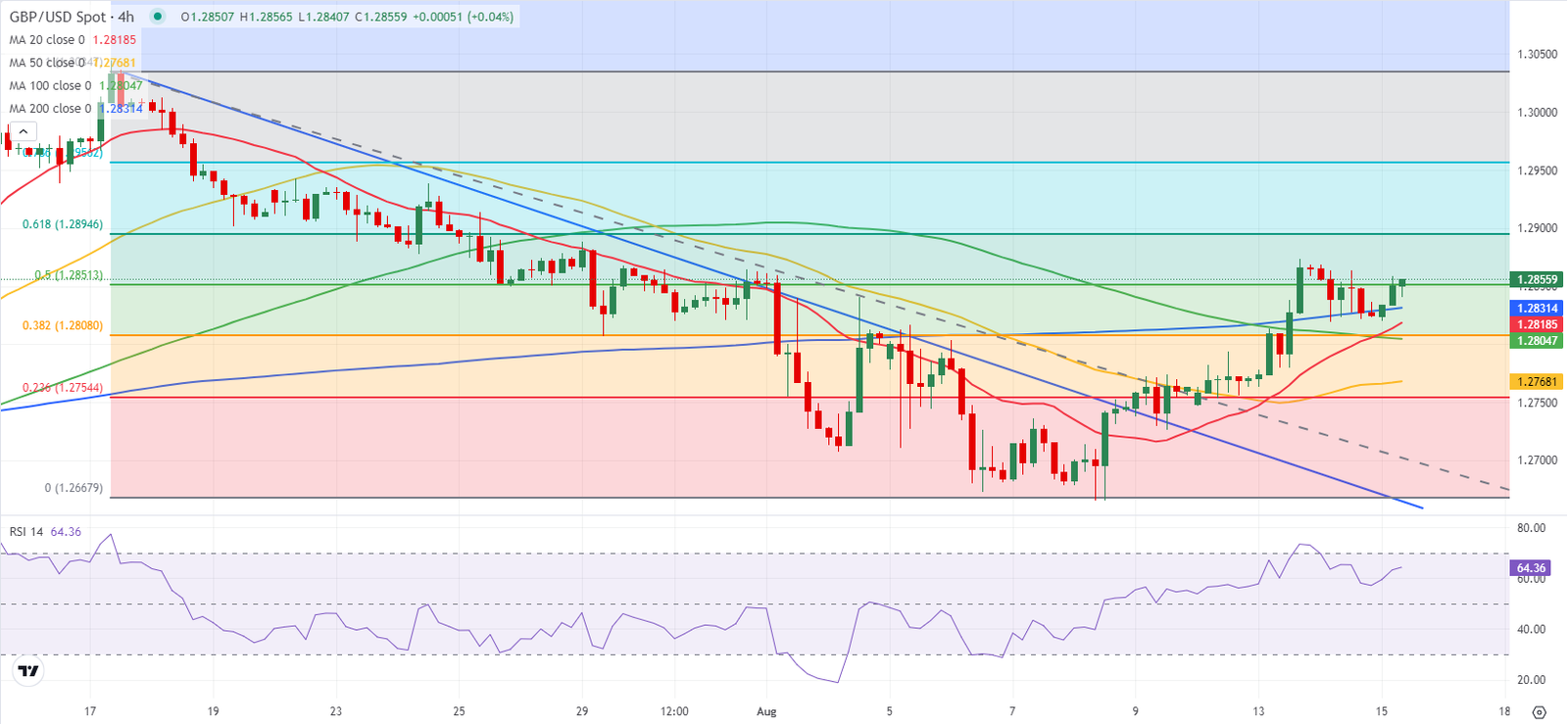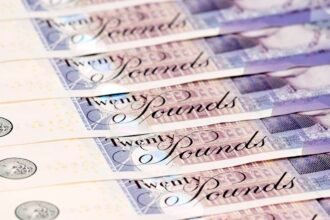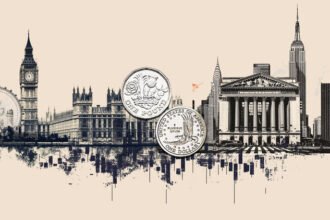- GBP/USD stays in positive territory near 1.2850 on Thursday.
- The pair’s technical outlook remains bullish following Wednesday’s pullback.
- Investors await mid-tier macroeconomic data releases from the US.
Following Tuesday’s upsurge, GBP/USD reversed its direction and closed in negative territory on Wednesday. The pair regains its traction and trades at around 1.2850 in the European session on Thursday.
British Pound PRICE This week
The table below shows the percentage change of British Pound (GBP) against listed major currencies this week. British Pound was the strongest against the Japanese Yen.
| USD | EUR | GBP | JPY | CAD | AUD | NZD | CHF | |
|---|---|---|---|---|---|---|---|---|
| USD | -0.88% | -0.73% | 0.50% | -0.24% | -0.78% | -0.12% | 0.18% | |
| EUR | 0.88% | 0.17% | 1.36% | 0.64% | -0.02% | 0.76% | 1.08% | |
| GBP | 0.73% | -0.17% | 1.46% | 0.47% | -0.19% | 0.58% | 0.90% | |
| JPY | -0.50% | -1.36% | -1.46% | -0.72% | -1.34% | -0.63% | -0.36% | |
| CAD | 0.24% | -0.64% | -0.47% | 0.72% | -0.59% | 0.12% | 0.44% | |
| AUD | 0.78% | 0.02% | 0.19% | 1.34% | 0.59% | 0.78% | 1.09% | |
| NZD | 0.12% | -0.76% | -0.58% | 0.63% | -0.12% | -0.78% | 0.31% | |
| CHF | -0.18% | -1.08% | -0.90% | 0.36% | -0.44% | -1.09% | -0.31% |
The heat map shows percentage changes of major currencies against each other. The base currency is picked from the left column, while the quote currency is picked from the top row. For example, if you pick the British Pound from the left column and move along the horizontal line to the US Dollar, the percentage change displayed in the box will represent GBP (base)/USD (quote).
Although the US Dollar (USD) struggled to outperform its rivals following the Consumer Price Index (CPI) figures on Wednesday, GBP/USD edged lower as the softer-than-forecast July UK inflation data weighed on Pound Sterling.
Early Thursday, the UK’s Office for National Statistics reported that the UK’s Gross Domestic Product (GDP) expanded at an annual rate of 0.9% in the second quarter. This reading followed the 0.3% growth recorded in the first quarter and came in line with the market expectation. Other data from the UK showed that Manufacturing Production and Industrial Production increased by 1.1% and 0.8%, respectively, on a monthly basis in June.
Upbeat UK data, combined with an improving risk mood, helped GBP/USD edge higher in the European session.
Later in the day, the weekly Initial jobless Claims and July Retail Sales data will be featured in the US economic docket. A noticeable decline in the number of first-time applications for unemployment benefits and an increase of 0.5%, or more, in Retail Sales could help the USD gather strength and limit GBP/USD’s upside.
Nevertheless, GBP/USD could look to stretch higher, even if the immediate reaction to the US data supports the USD, in case risk flows dominate the financial markets following the Wall Street’s opening bell. At the time of press, US stock index futures were up between 0.2% and 0.3%.
GBP/USD Technical Analysis
GBP/USD closed the last 4-hour candle comfortably above the 200-period Simple Moving Average and the Relative Strength Index recovered back above 60 after falling toward 50, highlighting sellers’ hesitancy.
1.2850 (Fibonacci 50% retracement of the latest uptrend) aligns as a pivot level for the pair. If GBP/USD manages to stabilize above this level, 1.2900 (Fibonacci 61.8% retracement) could be seen as next resistance before 1.2950 (Fibonacci 78.6% retracement). On the downside, first support is located at 1.2830 (200-period SMA) ahead of 1.2800 (100-period SMA, Fibonacci 38.2% retracement) and 1.2760 (Fibonacci 23.6% retracement).
Pound Sterling FAQs
The Pound Sterling (GBP) is the oldest currency in the world (886 AD) and the official currency of the United Kingdom. It is the fourth most traded unit for foreign exchange (FX) in the world, accounting for 12% of all transactions, averaging $630 billion a day, according to 2022 data. Its key trading pairs are GBP/USD, aka ‘Cable’, which accounts for 11% of FX, GBP/JPY, or the ‘Dragon’ as it is known by traders (3%), and EUR/GBP (2%). The Pound Sterling is issued by the Bank of England (BoE).
The single most important factor influencing the value of the Pound Sterling is monetary policy decided by the Bank of England. The BoE bases its decisions on whether it has achieved its primary goal of “price stability” – a steady inflation rate of around 2%. Its primary tool for achieving this is the adjustment of interest rates. When inflation is too high, the BoE will try to rein it in by raising interest rates, making it more expensive for people and businesses to access credit. This is generally positive for GBP, as higher interest rates make the UK a more attractive place for global investors to park their money. When inflation falls too low it is a sign economic growth is slowing. In this scenario, the BoE will consider lowering interest rates to cheapen credit so businesses will borrow more to invest in growth-generating projects.
Data releases gauge the health of the economy and can impact the value of the Pound Sterling. Indicators such as GDP, Manufacturing and Services PMIs, and employment can all influence the direction of the GBP. A strong economy is good for Sterling. Not only does it attract more foreign investment but it may encourage the BoE to put up interest rates, which will directly strengthen GBP. Otherwise, if economic data is weak, the Pound Sterling is likely to fall.
Another significant data release for the Pound Sterling is the Trade Balance. This indicator measures the difference between what a country earns from its exports and what it spends on imports over a given period. If a country produces highly sought-after exports, its currency will benefit purely from the extra demand created from foreign buyers seeking to purchase these goods. Therefore, a positive net Trade Balance strengthens a currency and vice versa for a negative balance.






















